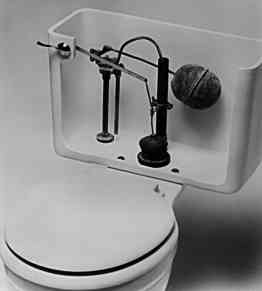These days, there are more toilet designs and models than ever before. This can be a great thing but it can also make shopping for a new toilet or updating an existing one a bit difficult. Add to that the fact that new regulations and codes are cropping up and it’s no wonder why modern plumbing confuses many consumers.

A newer term that has made its way into modern plumbing is “anti-siphon” or “backflow.” You might come across this term if you’re shopping for a new toilet or you’re preparing for a bathroom remodeling project. Let’s break down what anti-siphon means in the context of plumbing and why it’s something that you should be aware of.
Plumbing Protection: Anti-Siphon Prevention
From a plumbing perspective, anti-siphon prevention is a regulation code that protects homes and buildings from low water pressure. To provide some context, bathroom fixtures are hooked up to the residence’s water supply, which connects to the town’s or community’s water supply.
Normally, steady pressure allows this supply of water to make its way into the plumbing but there are some cases in which the pressure will drop. A good example is if the community fire department needs a ton of water to fight a fire. Since they’re using most of the water pressure, the flow in other homes and buildings is going to drop. As a result, it’s more likely that the water in the pipes will flow backward, seeping back into the plumbing system.
Why Is This a Problem?
The big deal about this is that if there are other particles or debris in the water supply when it flows back into the plumbing system, it can backflow into your home’s toilet. This is especially true for older toilets that weren’t built with anti-siphon protection. Backflow can become noticeable if you use a tank cleaner on these older toilets as the cleaning agent will trickle back into the water supply and start coming out of your bathtub or sink.
Fortunately, modern toilets are constructed with anti-siphon prevention built in but if you have an older toilet, then you might be susceptible to backflow. How can you know if your toilet is protected against backflow? First, check the ballcock (the refill valve in your toilet tank) for the words “anti-siphon” or “code-approved.” If you don’t see this distinguishing mark, then your refill valve is probably not protecting your toilet against backflow.
In some cases, the tank’s refill valve may be too short, allowing water in the tank to rise above the valve and threaten to overflow. Your best bet is to call in an expert plumber who can get you the code-approved parts that you need to set your mind at ease.
Why Should You Care?
Not having an anti-siphon toilet might not seem to be a huge deal but it can lead to higher water bills, which is something that no homeowner wants to deal with. When the water in the tank is flowing over the refill valve, it can cycle through your plumbing pipes, which wastes water and drives your utility bill higher.
In extreme cases, a lower-level toilet, such as one in a basement, can experience backwater issues if there is a waste or sewage backup in the pipes. Without a backwater valve, your toilet can end up spewing waste and flooding the bathroom. A backwater valve allows the wastewater in your toilet to go out but not come back in, making it a necessary component for many homes.
Wrapping up
In summary, anti-siphon and backflow prevention devices are installed in newer toilet models to keep contamination and pollution out of your home. These preventative valves protect your bathroom and family from sewage gases, soil-riddled water, and other contaminants flowing back into the water supply due to low-pressure scenarios.
Backflow can happen because of high demands on the water system (such as the fire department), freezing pipes, and water main bursts. As with most plumbing matters, it is better to be safe than sorry so look for toilets that meet backwater codes or enlist the help of a professional plumber who can ensure that your toilet has anti-siphon protection. A small investment now can save thousands of dollars later on.
Related Resources
http://sccmua.com/backup.htm
http://www.msdlouky.org/programs/backflow.htm
http://www.freepatentsonline.com/5406972.html
http://www.plbg.com/forum/read.php?1,328450
http://www.kcmo.org/water.nsf/web/backwater?opendocument
